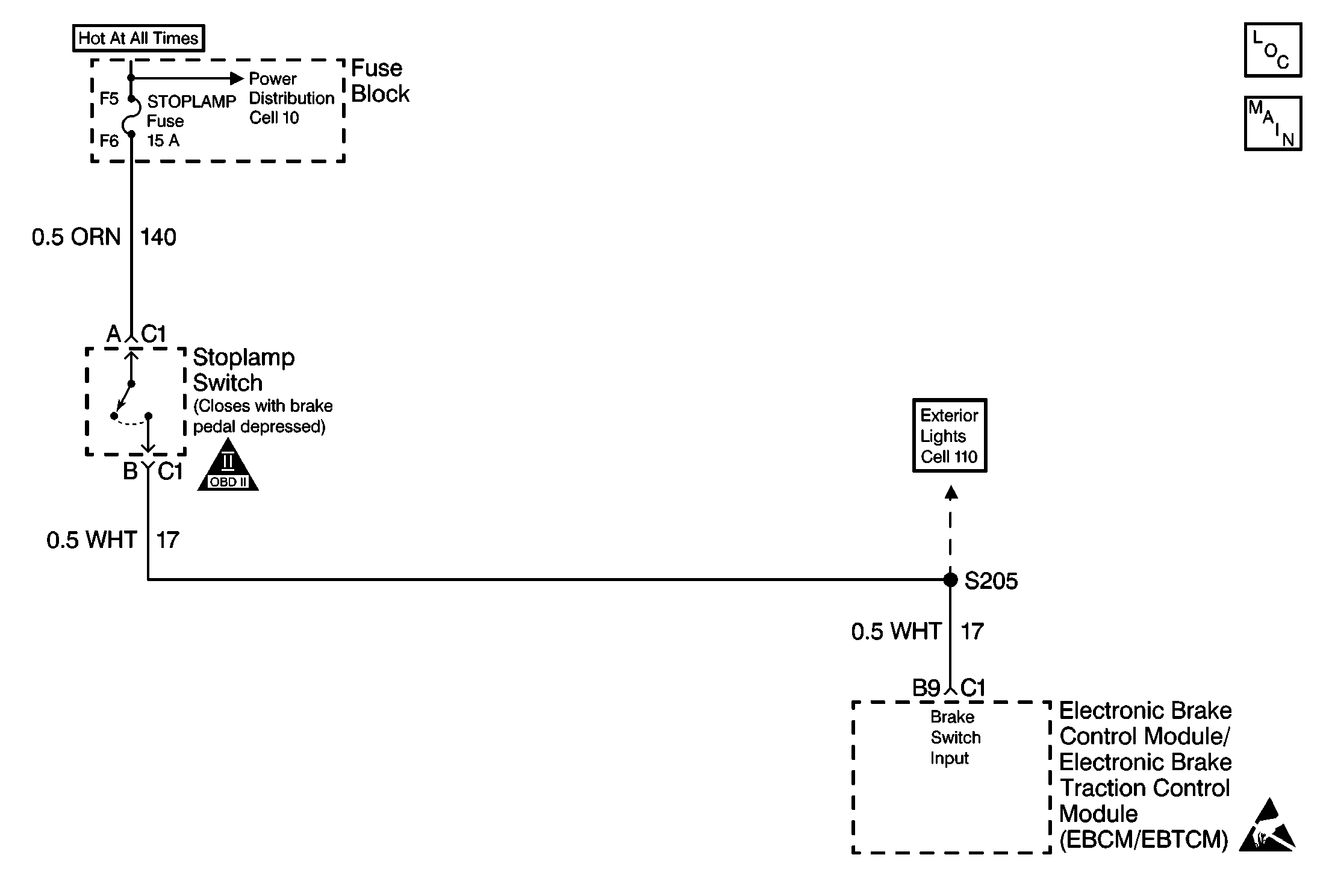
Circuit Description
DTC C1291 detects an open brake switch in the non-ABS mode. The EBCM/EBTCM looks for deceleration rates that may indicate braking action. The EBCM/EBTCM verifies braking action by repeating the method for finding deceleration rates that indicate braking action several times. In each case, the ABS will not be available because the EBCM/EBTCM does not see the brake switch input.
Conditions for Setting the DTC
DTC C1291 can set if three deceleration cycles within the specified rate occur during the current ignition cycle with the brake switch off.
Action Taken When the DTC Sets
| • | A malfunction DTC stores. |
| • | The ABS/ETS/TCS disables. |
| • | The amber ABS/ETS/TCS warning indicator(s) turns on. |
Conditions for Clearing the DTC
| • | The condition responsible for setting the DTC no longer exists and the Scan Tool Clear DTCs function is used. |
| • | 100 drive cycles pass with no DTC(s) detected. |
Diagnostic Aids
The following conditions may cause an intermittent malfunction:
| • | A poor connection |
| • | Rubbed-through wire insulation |
| • | A broken wire inside the insulation |
Use the enhanced diagnostic function of the Scan Tool in order to measure the frequency of the malfunction. Refer to the Scan Tool manual for the procedure.
Thoroughly inspect any circuitry that may cause the intermittent complaint for the following conditions:
| • | Backed out terminals |
| • | Improper mating |
| • | Broken locks |
| • | Improperly formed or damaged terminals |
| • | Poor terminal-to-wiring connections |
| • | Physical damage to the wiring harness |
Important: Zero the J 39200 test leads before making any resistance measurements. Refer to the J 39200 user's manual.
Step | Action | Value(s) | Yes | No | ||||||
|---|---|---|---|---|---|---|---|---|---|---|
1 | Was the Diagnostic System Check performed? | -- | Go to Diagnostic System Check | |||||||
2 |
Do not start the engine. Is DTC C1295 set as either a current and/or history DTC? | -- | ||||||||
3 |
Does the Scan Tool indicate that the brake switch is on within 25 mm (1.0 inch) of brake pedal travel? | -- | ||||||||
4 |
Are the rear brake lamps on? | -- | ||||||||
5 |
Do not start the engine. Is the voltage equal to or greater than the specified voltage? | 10.0 V | ||||||||
6 | Inspect the 24-way EBCM/EBTCM connector C1 and the 24-way EBCM/EBTCM harness connector C1 for the following conditions:
Is there poor terminal contact, terminal corrosion, or damaged terminals? | -- | ||||||||
7 |
Does DTC C1291 or DTC C1292 set as a current DTC? | -- | ||||||||
8 | Use the J 39200 in order to measure the voltage between the stoplamp switch harness connector C1 terminal A and ground. Is the voltage equal to or greater than the specified voltage? | 10.0 V | ||||||||
9 |
Is the voltage equal to or greater than the specified voltage? | 10.0 V | ||||||||
10 | Inspect for proper adjustment of the stoplamp switch. Is the stoplamp switch adjusted correctly? | -- | ||||||||
11 |
Is the resistance within the specified range? | 0.0-2.0 ohms | ||||||||
12 |
Is the resistance within the specified range? | 0.0-2.0 ohms | ||||||||
13 |
Is the resistance within the specified range? | OL (Infinite) | ||||||||
14 | Use the J 39200 in order to measure the voltage between the fuse block terminal F5 and ground. Is the voltage equal to or greater than the specified voltage? | 10 V | Go to Power Distribution Schematics in Wiring Systems | |||||||
15 |
Is the resistance within the specified range? | OL (Infinite) | ||||||||
16 | Repair the open in CKT 17. Is the repair complete? | -- | Go to Diagnostic System Check | -- | ||||||
17 | Replace all the terminal or the connectors that exhibit the following conditions:
Is the repair complete? | -- | Go to Diagnostic System Check | -- | ||||||
18 | Replace the stoplamp switch. Is the repair complete? | -- | Go to Diagnostic System Check | -- | ||||||
19 | Adjust the stoplamp switch. Is the repair complete? | -- | Go to Diagnostic System Check | -- | ||||||
20 |
Is the repair complete? | -- | Go to Diagnostic System Check | -- | ||||||
21 | Repair the open in CKT 140. Is the repair complete? | -- | Go to Diagnostic System Check | -- | ||||||
22 |
Is the repair complete? | -- | Go to Diagnostic System Check | -- | ||||||
23 | Replace the EBCM/EBTCM. Is the repair complete? | -- | Go to Diagnostic System Check | -- | ||||||
24 | Replace the STOPLAMP Fuse (15A) with a known good fuse (15A). Is the repair complete? | -- | Go to Diagnostic System Check | -- | ||||||
25 | The malfunction is intermittent or is not present at this time. Is the repair complete? | -- | Go to Diagnostic Aids | -- |
